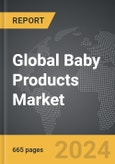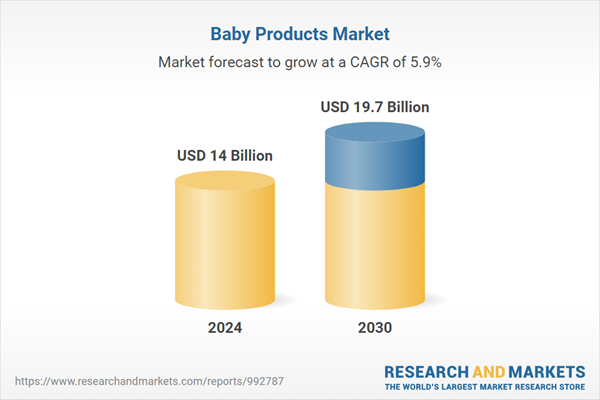The global market for Baby Products was valued at US$14.0 Billion in 2024 and is projected to reach US$19.7 Billion by 2030, growing at a CAGR of 5.9% from 2024 to 2030. This comprehensive report provides an in-depth analysis of market trends, drivers, and forecasts, helping you make informed business decisions. The report includes the most recent global tariff developments and how they impact the Baby Products market.
Technological advancements have significantly influenced the baby products market, leading to the development of smarter, safer, and more efficient products. For instance, baby monitors now come equipped with video capabilities, temperature sensors, and even Wi-Fi connectivity, allowing parents to keep a close watch on their babies from any location. Feeding products have also seen improvements, with anti-colic bottles, automated formula dispensers, and high chairs that grow with the child. Diapers have evolved to offer better absorption, leak protection, and skin-friendly materials, with some even featuring wetness indicators. Additionally, eco-conscious parents are increasingly opting for sustainable baby products, such as organic clothing, biodegradable diapers, and natural skincare items, driving manufacturers to adopt greener practices and materials. These technological and environmental advancements reflect the changing preferences and demands of modern parents, who prioritize convenience, safety, and sustainability.
The growth in the baby products market is driven by several factors. One significant driver is the increasing birth rate in various regions, coupled with rising disposable incomes, which enables parents to spend more on high-quality baby products. The growing awareness about child health and safety standards also fuels demand for premium and specialized baby items. The expansion of e-commerce platforms has made it easier for parents to access a wide variety of baby products, often accompanied by customer reviews and detailed product information that aids in making informed purchasing decisions. Technological advancements, such as the development of smart baby products and innovations in materials, continue to attract tech-savvy parents looking for the latest and most efficient solutions for their children. Additionally, the trend towards sustainable and eco-friendly products is gaining momentum, as environmentally conscious consumers seek out green alternatives for their babies. These factors, along with the continuous focus on research and development by manufacturers to introduce innovative and safe baby products, are expected to drive sustained growth in the baby products market in the coming years.
Segments: Product (Baby Cosmetic & Toiletries, Baby Food, Baby Safety & Convenience); Distribution Channel (Hypermarkets/Supermarkets, Convenience Stores, Online Platform, Other Distribution Channels).
Geographic Regions/Countries: World; USA; Canada; Japan; China; Europe; France; Germany; Italy; UK; Spain; Russia; Rest of Europe; Asia-Pacific; Australia; India; South Korea; Rest of Asia-Pacific; Latin America; Argentina; Brazil; Mexico; Rest of Latin America; Middle East; Iran; Israel; Saudi Arabia; UAE; Rest of Middle East; Africa.
The analysts continuously track trade developments worldwide, drawing insights from leading global economists and over 200 industry and policy institutions, including think tanks, trade organizations, and national economic advisory bodies. This intelligence is integrated into forecasting models to provide timely, data-driven analysis of emerging risks and opportunities.
Global Baby Products Market - Key Trends & Drivers Summarized
Baby products encompass a wide range of items designed to cater to the needs of infants and toddlers, ensuring their health, safety, comfort, and development. These products include essentials such as diapers, feeding bottles, baby food, clothing, and toys, as well as more specialized items like strollers, car seats, cribs, and baby monitors. The market for baby products is vast and diverse, reflecting the growing awareness among parents about the importance of quality and safety in products used by their children. Parents today seek items that not only meet basic needs but also offer additional benefits such as developmental support, convenience, and eco-friendliness. The industry is characterized by continuous innovation, with companies regularly introducing new products that incorporate the latest technological advancements and research findings.Technological advancements have significantly influenced the baby products market, leading to the development of smarter, safer, and more efficient products. For instance, baby monitors now come equipped with video capabilities, temperature sensors, and even Wi-Fi connectivity, allowing parents to keep a close watch on their babies from any location. Feeding products have also seen improvements, with anti-colic bottles, automated formula dispensers, and high chairs that grow with the child. Diapers have evolved to offer better absorption, leak protection, and skin-friendly materials, with some even featuring wetness indicators. Additionally, eco-conscious parents are increasingly opting for sustainable baby products, such as organic clothing, biodegradable diapers, and natural skincare items, driving manufacturers to adopt greener practices and materials. These technological and environmental advancements reflect the changing preferences and demands of modern parents, who prioritize convenience, safety, and sustainability.
The growth in the baby products market is driven by several factors. One significant driver is the increasing birth rate in various regions, coupled with rising disposable incomes, which enables parents to spend more on high-quality baby products. The growing awareness about child health and safety standards also fuels demand for premium and specialized baby items. The expansion of e-commerce platforms has made it easier for parents to access a wide variety of baby products, often accompanied by customer reviews and detailed product information that aids in making informed purchasing decisions. Technological advancements, such as the development of smart baby products and innovations in materials, continue to attract tech-savvy parents looking for the latest and most efficient solutions for their children. Additionally, the trend towards sustainable and eco-friendly products is gaining momentum, as environmentally conscious consumers seek out green alternatives for their babies. These factors, along with the continuous focus on research and development by manufacturers to introduce innovative and safe baby products, are expected to drive sustained growth in the baby products market in the coming years.
Report Scope
The report analyzes the Baby Products market, presented in terms of units. The analysis covers the key segments and geographic regions outlined below.Segments: Product (Baby Cosmetic & Toiletries, Baby Food, Baby Safety & Convenience); Distribution Channel (Hypermarkets/Supermarkets, Convenience Stores, Online Platform, Other Distribution Channels).
Geographic Regions/Countries: World; USA; Canada; Japan; China; Europe; France; Germany; Italy; UK; Spain; Russia; Rest of Europe; Asia-Pacific; Australia; India; South Korea; Rest of Asia-Pacific; Latin America; Argentina; Brazil; Mexico; Rest of Latin America; Middle East; Iran; Israel; Saudi Arabia; UAE; Rest of Middle East; Africa.
Key Insights:
- Market Growth: Understand the significant growth trajectory of the Baby Cosmetic & Toiletries segment, which is expected to reach US$10.3 Billion by 2030 with a CAGR of a 6.5%. The Baby Food segment is also set to grow at 5.5% CAGR over the analysis period.
- Regional Analysis: Gain insights into the U.S. market, valued at $2.0 Billion in 2024, and China, forecasted to grow at an impressive 7.0% CAGR to reach $6.4 Billion by 2030. Discover growth trends in other key regions, including Japan, Canada, Germany, and the Asia-Pacific.
Why You Should Buy This Report:
- Detailed Market Analysis: Access a thorough analysis of the Global Baby Products Market, covering all major geographic regions and market segments.
- Competitive Insights: Get an overview of the competitive landscape, including the market presence of major players across different geographies.
- Future Trends and Drivers: Understand the key trends and drivers shaping the future of the Global Baby Products Market.
- Actionable Insights: Benefit from actionable insights that can help you identify new revenue opportunities and make strategic business decisions.
Key Questions Answered:
- How is the Global Baby Products Market expected to evolve by 2030?
- What are the main drivers and restraints affecting the market?
- Which market segments will grow the most over the forecast period?
- How will market shares for different regions and segments change by 2030?
- Who are the leading players in the market, and what are their prospects?
Report Features:
- Comprehensive Market Data: Independent analysis of annual sales and market forecasts in US$ Million from 2024 to 2030.
- In-Depth Regional Analysis: Detailed insights into key markets, including the U.S., China, Japan, Canada, Europe, Asia-Pacific, Latin America, Middle East, and Africa.
- Company Profiles: Coverage of players such as Arla Foods Amba, Abbott Nutrition, Bellakt, Atlantic Grupa d.d., Asahi Group Holdings Ltd. and more.
- Complimentary Updates: Receive free report updates for one year to keep you informed of the latest market developments.
Some of the 305 companies featured in this Baby Products market report include:
- Arla Foods Amba
- Abbott Nutrition
- Bellakt
- Atlantic Grupa d.d.
- Asahi Group Holdings Ltd.
- Ausnutria Dairy Corporation Ltd.
- Albaad Deutschland GmbH
- Balactan Nutrition SL
- Babyganics Products Pbc
- American Hygienics Corporation
- AROMABABY Natural Skincare
- Artsana SpA - Chicco
- 7-Eleven, Inc.
- Am Nsw Pty Limited
- Alife
Tariff Impact Analysis: Key Insights for 2025
Global tariff negotiations across 180+ countries are reshaping supply chains, costs, and competitiveness. This report reflects the latest developments as of April 2025 and incorporates forward-looking insights into the market outlook.The analysts continuously track trade developments worldwide, drawing insights from leading global economists and over 200 industry and policy institutions, including think tanks, trade organizations, and national economic advisory bodies. This intelligence is integrated into forecasting models to provide timely, data-driven analysis of emerging risks and opportunities.
What’s Included in This Edition:
- Tariff-adjusted market forecasts by region and segment
- Analysis of cost and supply chain implications by sourcing and trade exposure
- Strategic insights into geographic shifts
Buyers receive a free July 2025 update with:
- Finalized tariff impacts and new trade agreement effects
- Updated projections reflecting global sourcing and cost shifts
- Expanded country-specific coverage across the industry
Table of Contents
I. METHODOLOGYII. EXECUTIVE SUMMARYIII. MARKET ANALYSISSOUTH KOREAREST OF ASIA-PACIFICARGENTINABRAZILMEXICOREST OF LATIN AMERICAIRANISRAELSAUDI ARABIAUNITED ARAB EMIRATESREST OF MIDDLE EASTIV. COMPETITION
1. MARKET OVERVIEW
2. FOCUS ON SELECT PLAYERS
3. MARKET TRENDS & DRIVERS
4. GLOBAL MARKET PERSPECTIVE
UNITED STATES
CANADA
JAPAN
CHINA
EUROPE
FRANCE
GERMANY
ITALY
UNITED KINGDOM
SPAIN
RUSSIA
REST OF EUROPE
ASIA-PACIFIC
AUSTRALIA
INDIA
LATIN AMERICA
MIDDLE EAST
AFRICA
Companies Mentioned (Partial List)
A selection of companies mentioned in this report includes, but is not limited to:
- Arla Foods Amba
- Abbott Nutrition
- Bellakt
- Atlantic Grupa d.d.
- Asahi Group Holdings Ltd.
- Ausnutria Dairy Corporation Ltd.
- Albaad Deutschland GmbH
- Balactan Nutrition SL
- Babyganics Products Pbc
- American Hygienics Corporation
- AROMABABY Natural Skincare
- Artsana SpA - Chicco
- 7-Eleven, Inc.
- Am Nsw Pty Limited
- Alife
Table Information
| Report Attribute | Details |
|---|---|
| No. of Pages | 665 |
| Published | April 2025 |
| Forecast Period | 2024 - 2030 |
| Estimated Market Value ( USD | $ 14 Billion |
| Forecasted Market Value ( USD | $ 19.7 Billion |
| Compound Annual Growth Rate | 5.9% |
| Regions Covered | Global |









